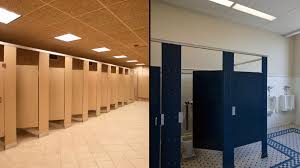Have you ever paused in a public restroom and wondered why the stall doors float awkwardly above the floor?
At first, it seems like a strange design flaw—as if privacy was sacrificed for no good reason. But that familiar gap isn’t an accident. In fact, it’s a deliberate design choice rooted in safety, sanitation, efficiency, and practicality.
What looks like a lack of attention to detail is actually the result of careful planning. Public restrooms are high-traffic spaces, and the seemingly odd door gap helps them function smoothly.
Why Public Stall Doors Don’t Reach the Floor
1. A Built-In Safety Measure

The opening beneath the door allows a quick visual check if someone inside needs help. If a person collapses, faint, or becomes unresponsive, the visibility under the door helps staff or emergency responders determine whether intervention is necessary.
In urgent situations, the gap can even be used to pass items—like a phone, medical tools, or keys—without breaking down the door. Without this small opening, response times could be delayed, which is especially dangerous in a crowded public facility.
2. Better Ventilation and Airflow
Restrooms require strong air circulation to reduce odors, control humidity, and prevent mold growth. Doors that stop above the floor allow air to move more freely from stall to stall, making ventilation systems far more effective.
This airflow helps maintain a fresher, more sanitary environment—something any restroom visitor can appreciate.
3. Faster, Easier Cleaning
For cleaning crews, the gap is incredibly practical. Floors can be mopped swiftly without needing to unlock or enter each stall. Spills, leaks, or messes are easier to spot from the outside, which helps maintenance teams address problems before they spread.
This small design detail reduces cleaning time and makes the restroom overall more hygienic for users.
4. Lower Costs and Fewer Repairs
From a construction standpoint, full-length stall doors are more expensive and more complicated to install. Uneven floors in public spaces can cause ground-level doors to drag, warp, or break.
Raised doors reduce wear on hinges and hardware, making them more durable and cheaper to maintain in the long run. The reduced cost and simplicity make them the preferred choice for most public buildings.
5. A Reasonable Trade-Off Between Privacy and Function
Yes—these gaps slightly reduce privacy. But building designers consider the benefits worth the compromise. The improved airflow, increased safety, easier maintenance, and reduced construction costs create a system that works well for high-traffic environments.
While full-privacy bathrooms are ideal in private homes or upscale establishments, public restrooms prioritize functionality and safety over complete enclosure.
Conclusion
The gap beneath public restroom doors might seem odd or inconvenient, but it’s far from a mistake. It’s a carefully considered design feature that enhances safety, boosts ventilation, simplifies cleaning, and lowers construction and maintenance costs.
What looks like a privacy flaw is actually a smart solution to the challenges of managing a busy public space. So the next time you notice that unmistakable strip of openness under a stall door, remember: it serves a purpose—one that makes restrooms cleaner, safer, and more efficient for everyone who uses them.
